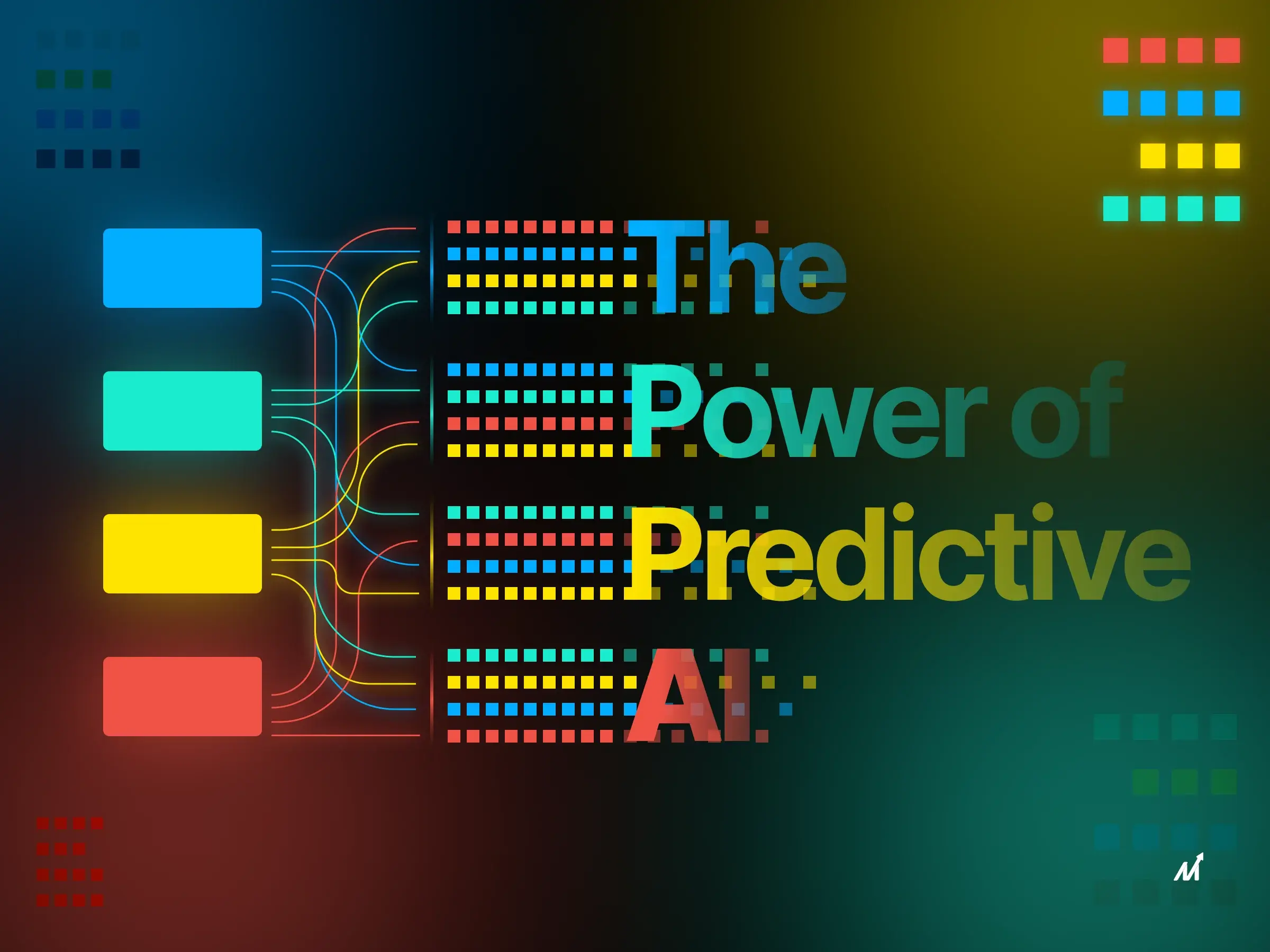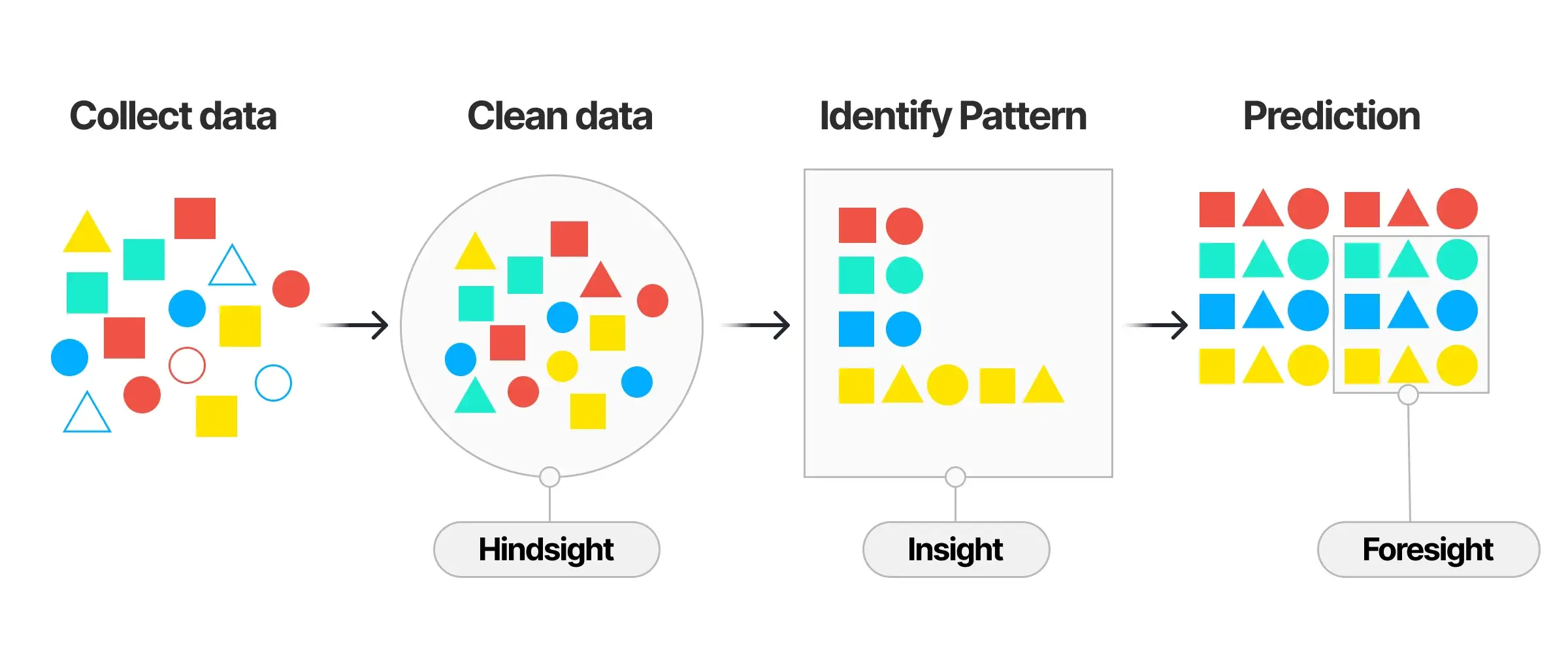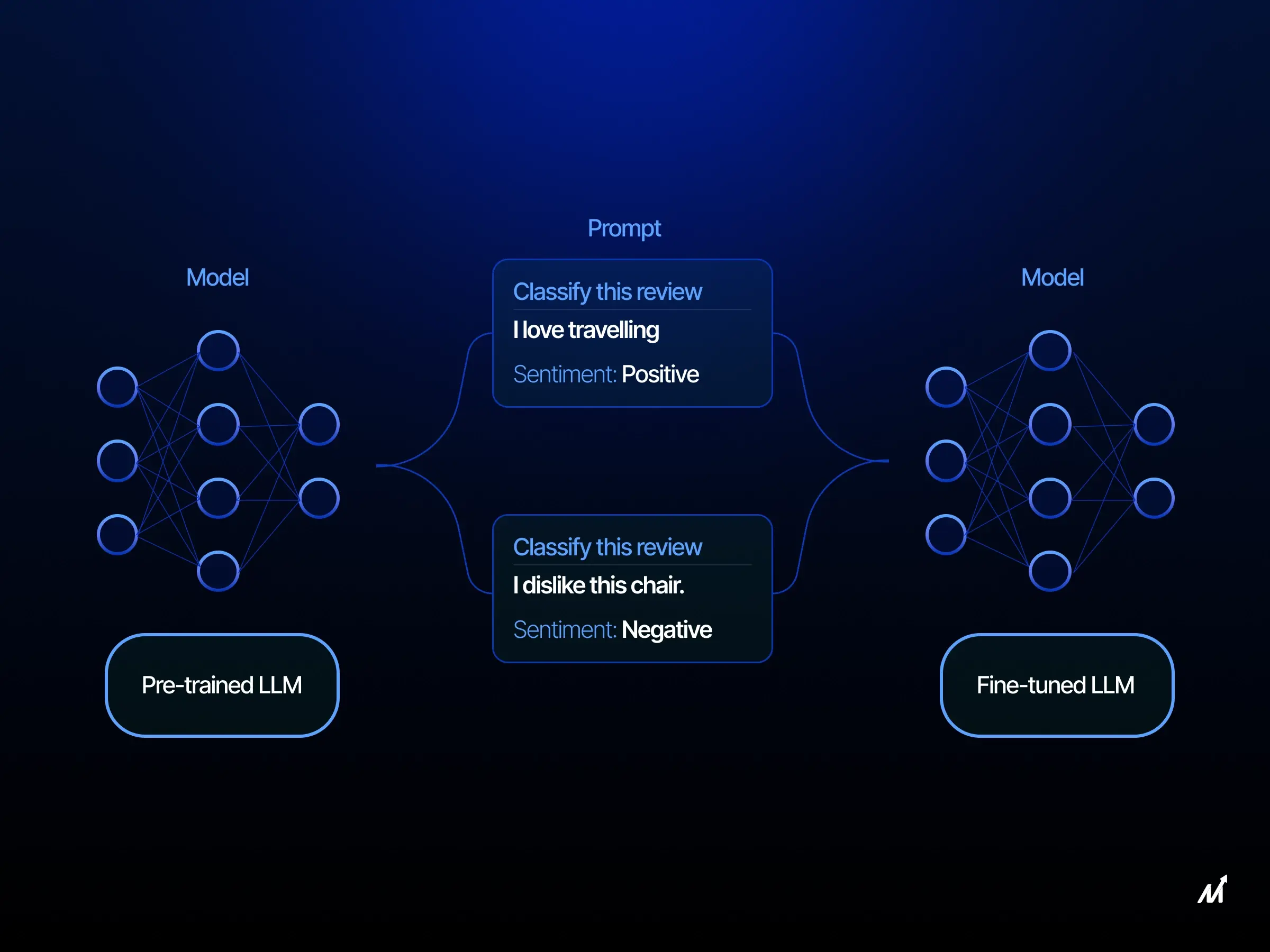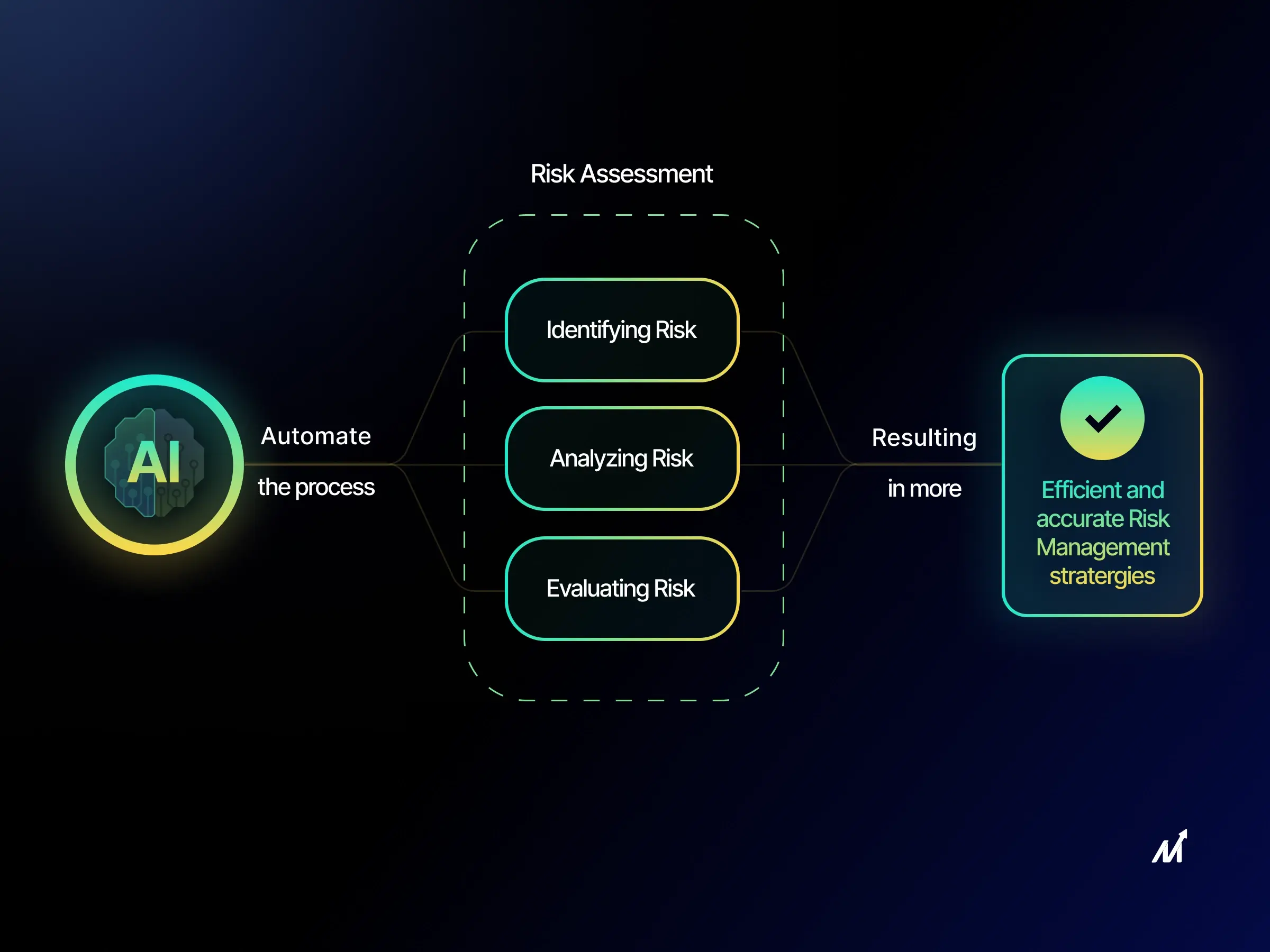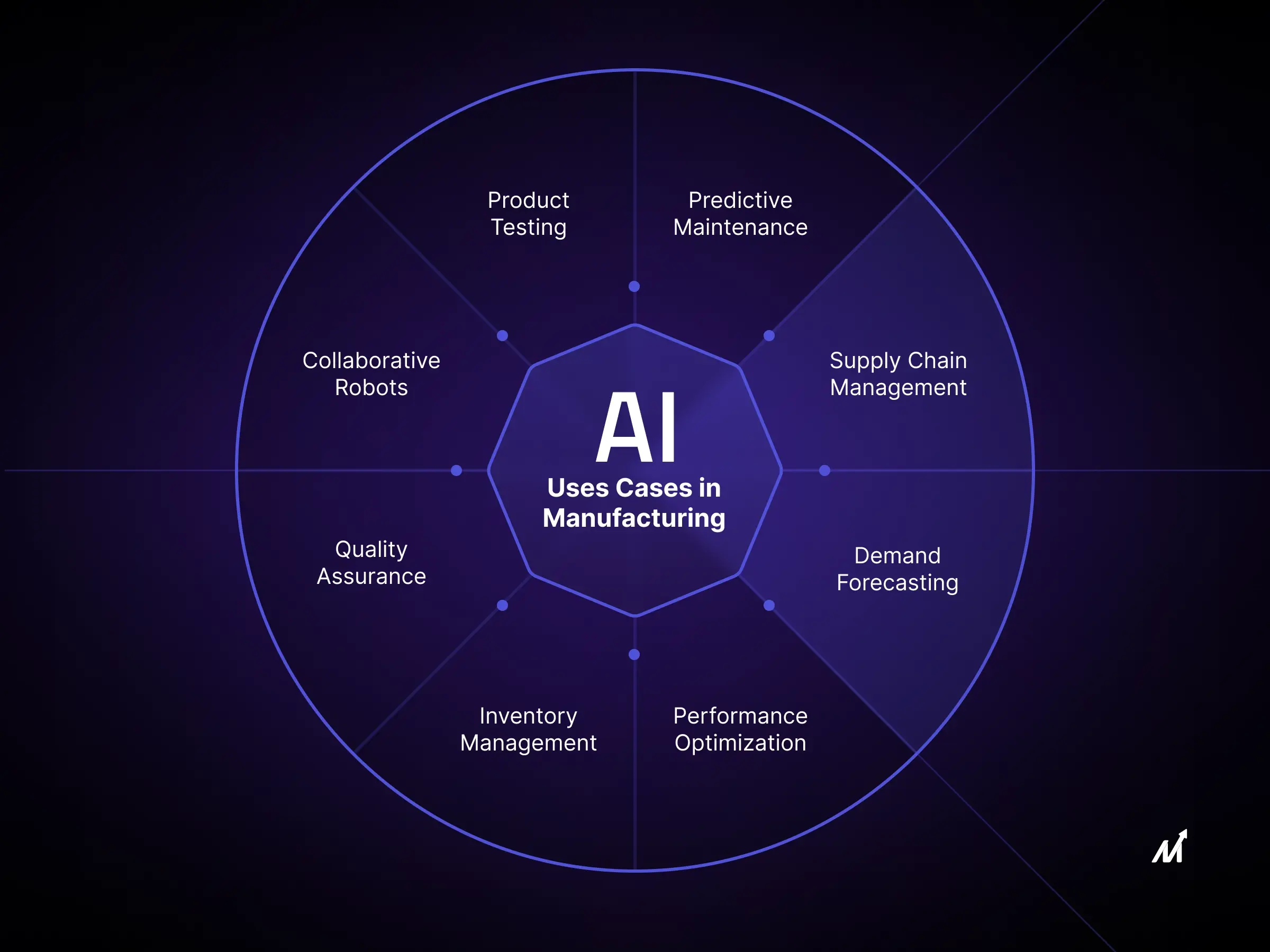The AI market is all set to grow at a rapid 37.3% CAGR from 2023 to 2030, reaching an approximately $1,811.8 billion, with Predictive AI playing a key role in this surge. In the world of business, staying one step ahead is crucial. That’s where Predictive AI comes in, offering companies a way to look into the future. Businesses are now using Predictive AI to make smarter decisions, reduce risks, and find new ways to grow.
In this blog, we’ll explain how Predictive AI is changing the game for businesses big and small. We’ll look at real examples and understand how they work in everyday situations. It’s about understanding how this technology can be valuable in your business toolkit, helping you make better, more informed decisions. Whether you’re a tech expert or new to this, the goal is to show how Predictive AI can be a game-changer for your business.
What is Predictive AI?
Predictive AI is more than a conceptual branch of artificial intelligence; it’s a practical tool that transforms vast data arrays into insightful forecasts. This technology, rooted in machine learning, empowers systems to learn autonomously, recognize intricate patterns, and make informed decisions with minimal human input. By training algorithms on diverse datasets, Predictive AI models are equipped to make educated guesses about unseen future data.
The journey of Predictive AI is methodical and precise. It begins with data preprocessing, where unstructured data is refined and readied for analysis. Then, during the training phase, algorithms like neural networks and decision trees digest this data, learning to predict future outcomes. This phase is crucial for fine-tuning the model’s accuracy.
These models are applied in real-world contexts upon validation, continuously evolving and refining their predictive capabilities with new data influx. Now, let’s explore concrete examples of how Predictive AI is reshaping various industries.
Predictive AI in Various Industries
- Retail – Anticipating Consumer Behavior: Amazon uses predictive AI to forecast consumer buying patterns and suggest products based on previous purchases and searches. This not only enhances the customer experience but also streamlines inventory management.
- Banking – Credit Risk Analysis: Banks like JPMorgan Chase employ Predictive AI to assess credit risk, analyzing customer data to predict loan default likelihood, thus informing lending decisions and reducing financial risks.
- Healthcare – Predictive Diagnostics: Healthcare institutions, such as Mayo Clinic, leverage Predictive AI to analyze patient data, predicting diseases like cancer earlier than traditional diagnostic methods. This leads to early intervention and improved patient outcomes.
- Manufacturing – Predictive Maintenance: General Electric harnesses Predictive AI in its Predix platform to predict equipment failures before they occur, minimizing downtime and saving costs in manufacturing processes.
- Transportation – Traffic Flow Optimization: Urban planners use Predictive AI to analyze traffic patterns, optimizing traffic light sequences to reduce congestion, as seen in cities like Los Angeles.
How Does Predictive AI Work?
As you know Predictive AI analyzes historical data using algorithms, forecasting future trends and behaviors for informed decision-making in various sectors. But here is how exactly it works.
1. Data Analysis and Pattern Recognition
- Machine Learning Algorithms: Predictive AI uses machine learning algorithms to analyze historical data. These algorithms, such as linear regression, decision trees, and neural networks, are designed to recognize patterns and correlations between different data elements. For instance, a neural network might analyze sales data to find patterns correlating marketing spending with sales figures.
- Feature Extraction: The key to this process is extracting features – characteristics or attributes that can be used to predict outcomes. In a retail sales prediction, features might include historical sales data, time of year, marketing spending, and economic indicators.
2. Learning from Data
- Training the Model: The core of Predictive AI lies in training the model. During training, the algorithm processes the training dataset, adjusting its internal parameters to lessen the difference between its predictions and the actual outcomes. For example, in linear regression, the algorithm adjusts the weights of different features to minimize prediction error.
- Refinement with Feedback: Many Predictive AI systems use feedback loops to refine their predictions. This means they learn continuously, adjusting their parameters whenever new data comes in, or predictions are off the mark.
3. Making Predictions
- Application of the Model: Once trained, the model applies what it has learned to new, unseen data to make predictions. It can accurately forecast future outcomes if trained on sufficient, well-selected, and representative data.
- Probability and Statistics: Predictive AI often deals with probabilities. For example, it might predict an 80% chance of sales increasing by 10% in the next quarter based on current trends.
4. Continuous Improvement
- Adaptation and Evolution: A critical aspect of Predictive AI is its ability to adapt over time. The model refines its predictions as it receives new data, making it more accurate. This is particularly evident in systems using neural networks, which can adjust their internal structures in response to new data.
5. Real-World Implementation
- Integration with Business Systems: In practice, Predictive AI is integrated into business systems, where it processes incoming data (like sales figures, customer feedback, and market trends) and updates its predictions. These updated forecasts are then used for making strategic decisions, like adjusting marketing strategies for managing inventory.Predictive AI, therefore, is a blend of statistical analysis, pattern recognition, probabilistic forecasting, and continuous learning from data. It’s not just about processing data but about learning from it to make increasingly accurate predictions about future events.(Read about Enterprise AI here)
Predictive AI Implementation Stages
Predictive AI is a powerful tool that allows businesses and enterprises to forecast future trends and behaviors by analyzing existing data. Its implementation can be broken down into several detailed stages, each critical to the success of the predictive model.
1. Data Collection
The first stage in Predictive AI is gathering relevant data, forming the entire process’s foundation. This data can come from various sources, such as transaction records, customer interactions, sensors, and online activities. The quality and quantity of this data are vital since the accuracy of predictions depends on it. Businesses must ensure the collected data is representative of the problem at hand and is gathered ethically & in compliance with data privacy regulations.
2. Data Preprocessing
Once data is collected, it needs to be prepared for analysis. This stage involves cleaning and transforming the data into a usable format. Data cleaning includes handling missing values, removing duplicates, and correcting errors. Transformation involves normalizing or scaling the data and possibly engineering features – creating new variables from existing data that might provide additional insights.
3. Data Splitting
The prepared dataset is split into two parts: training & test sets. The training set is helpful to build and train the predictive model, while the test set is used to evaluate its performance. Typically, about 70-80% of the data is used for training and the remaining 20-30% for testing, although these ratios can vary based on the project’s specifics.
4. Model Selection
Selecting the right model is crucial in Predictive AI. The choice depends on the nature of the prediction task (classification, regression, etc.) and the data characteristics. Commonly used models include linear regression for continuous outcomes, logistic regression for binary outcomes, decision trees, random forests, and neural networks. Each model has its strengths and weaknesses; sometimes, a combination of models (ensemble methods) is used for better accuracy.
5. Model Training
During this stage, the chosen model learns from the training data set. The model attempts to find patterns & relationships within the data that it can use to make predictions. This process involves adjusting the model’s parameters to minimize prediction error. Techniques such as cross-validation are used to ensure that the model doesn’t just memorize the training data (overfitting) but generalizes well to new, unseen data.
6. Model Evaluation
After training, the model is being tested using the test dataset. This stage assesses the model’s performance and accuracy. Metrics such as Mean Squared Error (MSE) for regression tasks or Accuracy, Precision, and Recall for classification tasks are used. If the model’s performance is unsatisfactory, adjustments are made. This might involve going back to data preprocessing, trying a different model, or tweaking the model parameters.
7. Model Deployment
Once the model is adequately trained and tested, it’s deployed into a production environment where it can start making real-world predictions. This step might involve integrating the model into existing business systems or processes.
8. Model Monitoring and Updating
The final stage involves continuously monitoring and updating the model’s performance as necessary. Since the real-world data can change over time, the model might need retraining with new data to maintain its accuracy and relevance.
Predictive AI is a dynamic, iterative process. Its successful implementation requires a careful and thorough approach at each stage to ensure that the predictions it provides can effectively guide business decisions and strategies.
The Potential of Predictive AI Across Industries
1. Weather Forecasting
Predictive AI in meteorology is not just about better rain predictions; it’s about understanding complex climatic systems. AI models sift through diverse data – from ocean temperatures to wind patterns – to accurately forecast weather. This means more reliable planning for events, agricultural activities, or logistics for businesses, with a clearer understanding of potential weather disruptions.
2. Financial Analysis
The financial world benefits immensely from predictive AI. AI algorithms analyze market trends, consumer behavior, and economic indicators to forecast market shifts. This isn’t just about predicting stock prices; it’s about understanding the financial health of entire sectors and helping businesses in budget forecasting, investment planning, and risk management.
3. Healthcare Diagnostics
In healthcare, predictive AI does more than diagnose diseases. It analyzes genetic information, lifestyle data, and environmental factors to predict health risks. This proactive approach allows for personalized healthcare plans, better disease prevention strategies, and more effective treatment options, ultimately leading to a healthier population and reduced healthcare costs.
4. Supply Chain Management
Predictive AI transforms supply chain operations by forecasting demand with precision. It goes beyond analyzing past sales data; it considers market trends, socio-economic indicators, and weather forecasts to predict product demand. This ensures optimal stock levels, reduces waste, and enhances customer satisfaction by ensuring product availability.
5. Retail Personalization
Predictive AI tailors the shopping experience in retail by understanding individual customer preferences. It’s not just about recommending products based on past purchases; it’s about creating a personalized shopping journey. By analyzing browsing habits, purchase history, and even social media interactions, AI helps retailers offer targeted promotions and personalized product suggestions, enhancing customer engagement and loyalty.
6. Manufacturing Efficiency
In manufacturing, predictive AI optimizes production processes. It’s about predicting machine maintenance needs, optimizing production schedules, and reducing downtime. By analyzing historical operation data and real-time inputs from machines, AI helps manufacturers predict potential issues before they occur, ensuring smoother, more efficient operations.
7. Energy Management
Predictive AI in energy management is revolutionizing how we use resources. It forecasts energy demand and adjusts supply accordingly. This is not just about efficient energy distribution; it’s about integrating renewable energy sources effectively, reducing waste, and minimizing environmental impact.
8. Traffic Management
In urban planning, predictive AI optimizes traffic flow. Analyzing traffic patterns, commuter data, and road conditions predicts congestion points and suggests alternative routes. This reduces traffic jams, lowers emission levels, and a smoother transportation system.
(Also read about AI in Fashion and AI in Logistics)
Understanding Generative AI vs Predictive AI
| Aspect | Generative AI | Predictive AI |
| Primary Purpose | Creation of new content (digital artist) | Making predictions based on past data (digital fortune teller) |
| Functionality | Produces unique output from minimal inputs | Analyzes existing information to forecast future events |
| Input Dynamics | Starts with a simple prompt (text, image, music notes) | Uses historical data (sales records, weather reports, etc.) |
| Output Dynamics | Generates a new, creative product | Provides predictions or forecasts |
| Data and Learning Approach | Utilizes neural networks and generative adversarial networks | Relies on statistical methods and machine learning models |
| Real-World Applications | Creative tasks in marketing, entertainment, etc. | Planning and forecasting in finance, retail, healthcare, etc. |
| Complexity | Technologically complex, less user interaction post-input | More interactive, requires ongoing data input and user interpretation |
| User Interaction | Initial input followed by AI-led creation | Continual data feeding and adjustments, active user role |
1. Primary Purpose and Functionality
- Generative AI: This form of AI is all about creation. It’s used to produce new content – think of it as a digital artist. This could be anything from writing a text to creating a new image or a piece of music. Its main job is to take a small amount of input, like a sentence or an image, and use it to create something new and unique.
- Predictive AI: Predictive AI, on the other hand, is like a digital fortune teller. It looks at past data and uses it to make predictions. This could be forecasting sales for the next quarter, predicting weather patterns, or determining when a machine might need maintenance. It’s all about analyzing existing information to predict what will happen next. (Read about Generative AI Applications)
2. Input and Output Dynamics
- Generative AI: It starts with a base – a prompt, a picture, or a few notes of music – and from there, it builds something entirely new. The output is a creative product that didn’t exist before.
- Predictive AI: Here, the input is historical data – sales records, weather reports, machinery performance logs, etc. The output is not something new but a prediction or a forecast based on that data.
3. Approach to Data and Learning
- Generative AI uses advanced techniques like neural networks (think of these as complex digital brains) and generative adversarial networks (where two AI systems challenge each other to improve). It learns from examples it’s given and tries to replicate or innovate based on those.
- Predictive AI: This relies on established statistical methods and machine learning models. It looks at past data, finds patterns, and uses those to make informed guesses about the future.
4. Application in Real-World Scenarios
- Generative AI: It’s great for creative tasks. For example, marketing can generate unique ad copy or design new product concepts. In entertainment, it can create music or write scripts.
- Predictive AI: It shines in planning and forecasting. In finance, it helps with predicting stock trends. In retail, it can forecast product demand. It’s also useful in healthcare for predicting disease outbreaks or patient outcomes.
5. Complexity and User Interaction
- Generative AI: It tends to be more complex regarding the technology behind it. The user gives an initial input, but after that, the AI is largely on its own in the creative process.
- Predictive AI: This is more interactive with the user. It requires constant feeding of data and adjustments based on new information. The user plays a very active role in interpreting and applying the predictions.
Which Companies are Using Predictive AI?
Many different types of companies are using predictive AI to improve their operations. Here are some examples of industries where it’s being used:
- Retail companies, like the Casino group and U stores, use it to manage their stock and plan promotions effectively.
- Luxury brands use predictive AI to maintain high-quality production and forecast demand accurately.
- In the pharmaceutical industry, companies like Bayer and Alter Pharma use it for drug development and managing their supply chains.
- Transportation giants like SNCF and Corsica Ferries use predictive AI to optimize routes and schedules.
- Big IT companies like Cisco, Oracle, and Microsoft use it to improve resource allocation and customer support.
Predictive AI can help businesses in various sectors make smarter decisions and operate more efficiently.
Enhance Your Business Forecasting with Markovate’s Predictive AI
Markovate excels in crafting specialized Predictive AI solutions, targeting the intricacies of business data to unlock strategic foresight. Our expertise lies in blending deep analytical skills with advanced AI methodologies, delivering innovative and functional solutions.
Our Predictive AI offerings for businesses include, but are not limited to:
- Data-Driven Market Forecasting: This AI tool sifts through complex market data to provide accurate forecasts, aiding in strategic planning and decision-making.
- Customer Behavior Prediction System: Tailored to understand customer patterns, this solution predicts buying behaviors, enhancing customer engagement and driving sales.
- Operational Efficiency Optimizer: This AI solution forecasts potential bottlenecks by analyzing operational data, ensuring smoother workflows and higher productivity.
- Resource Allocation AI Advisor: This tool aids in optimal resource distribution by predicting future needs, preventing resource wastage, and maximizing utilization.
- Supply Chain Disruption Anticipator: Designed for preemptive supply chain management, it forecasts potential disruptions, allowing for timely countermeasures.
- Sales Trend Analyzer: This AI solution provides insights into emerging sales trends, helping businesses adapt their strategies for maximum impact.
- AI-Powered Risk Assessment Tool: It evaluates various factors to predict risks, enabling businesses to mitigate potential threats proactively.
- Customer Satisfaction Predictor: By analyzing customer feedback and behavior, this tool predicts satisfaction levels, guiding improvements in service and product offerings.
- Inventory Demand Forecasting System: Optimizes inventory levels by predicting future demand and balancing stock levels with market needs.
- Market Expansion AI Analyst: This tool assesses various market variables to predict the success of potential new markets or product lines.
We engage closely with our clients to ensure our solutions are cutting-edge and perfectly aligned with their business goals. Connect with the Markovate team today for a detailed discussion on how our Predictive AI solutions can transform your business strategy.
FAQs
1. What is Predictive AI, and How Does It Work?
Predictive AI is artificial intelligence that uses algorithms & statistical models to analyze historical data and predict future events. It identifies patterns and trends in the data and then applies these insights to forecast outcomes. This technology is widely popular in various fields, such as finance, marketing, healthcare, and supply chain management, to enhance decision-making processes.
2. What Are the Key Benefits of Using Predictive AI in Business?
The primary benefits of using predictive AI in business include improved decision-making, increased efficiency, and enhanced customer experiences. Predictive AI can help businesses anticipate market trends, optimize operations, personalize customer interactions, and reduce risks by providing data-driven forecasts and insights. This leads to better resource allocation, improved product development, and higher customer satisfaction.
3. How Can Predictive AI Be Integrated into Existing Business Processes?
Integrating predictive AI into existing business processes typically involves collecting and analyzing relevant data, choosing suitable AI models, and implementing these models into business operations. Businesses often start with areas where data is readily available, and predictions can yield significant benefits, such as sales forecasting, customer behavior analysis, or inventory management. Collaboration with AI consultants can ensure a smooth integration that aligns with business objectives.
4. What Are the Challenges and Limitations of Predictive AI?
The challenges of predictive AI include data quality and availability, model accuracy, ethical considerations, and the potential for bias. High-quality, relevant data is crucial for accurate predictions, and AI models must be continuously updated to reflect changing patterns. Additionally, ethical considerations, such as privacy concerns and the potential misuse of AI predictions, must be addressed. Finally, businesses must be cautious of inherent biases in data that could skew AI predictions.
5. How Does Predictive AI Differ from Other Types of AI, Like Prescriptive or Descriptive AI?
Predictive AI focuses on forecasting future events based on historical data. In contrast, descriptive AI analyzes past data to understand what has happened, and prescriptive AI suggests actions to achieve desired outcomes. Predictive AI provides insights into what is likely to happen, descriptive AI offers a detailed look at past events, and prescriptive AI combines predictive and descriptive AI insights to recommend specific courses of action. Each type serves a different purpose but can be complementary in business strategies.

